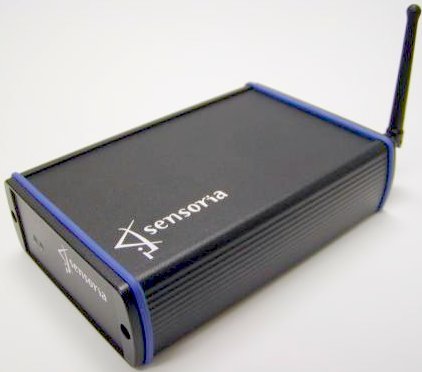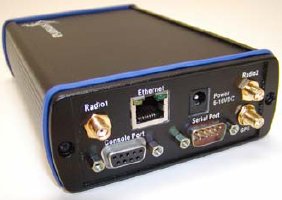Device Profile: Sensoria EnRoute400 mesh router for first responders
Jan 27, 2005 — by LinuxDevices Staff — from the LinuxDevices Archive — 3 viewsSensoria used Linux in a wireless mesh router for first responders that has also been deployed by front-line US infantry in Afghanistan. The EnRoute400 runs a 2.6-series Linux kernel, supports a variety of wireless radios, and uses a proprietary mesh networking stack that supports voice, video, and other high-bandwidth signals.

The EnRoute400 includes an 802.11b radio
The EnRoute400 can be deployed in vehicles or as a wearable device, according to Sensoria's VP of engineering Bud Patterson. Patterson says the device has been used in a variety of military applications, including exploratory robots and “cave clearers.” It was also worn by an Army infantry division at a “forward operating base” in Afghanistan, Patterson says.
In addition to its military customers, which include the US Army and Navy, Sensoria is also marketing the EnRoute400 to first responders, such as firefighters, police, and other emergency workers.
The EnRoute400 includes a built-in 802.11b radio, and units within operating range form a self-configuring, self-healing ad hoc wireless mesh network, according to Patterson. The device can support a wide variety of other radios, including 802.11g, 802.15.4, 802.16, and 4.9GHz-band devices, thanks to PCMCIA and RS232 expansion ports, and can bridge between various networks, Patterson says. “For example, you could hook a PDA running VoIP software to it,” Patterson notes.
Patterson says Sensoria has written suitable Linux drivers for a wide variety of radios. The device includes VPN software supporting 128-bit AES encryption.
The device includes an Ethernet port, which can serve as the attachment point for web cams or for “long-haul reachback” radios, Patterson says. It can also be used to connect the device to a wired Internet connection.
Proprietary mesh technology
The EnRoute400 uses Sensoria's proprietary WirelessFabric mesh networking protocol, described as a “radio-independent wireless networking software suite” that can route and repeat network traffic to create a wireless VPN (virtual private network) for peer-to-peer and peer-to-many communications. WirelessFabric supports MAODV multihop routing, TCP/UDP Unicast, UDP multicast, subnet addressing, and 128-bit AES encryption, and can scale to 100s or even thousands of devices, Sensoria claims.
Patterson says Sensoria prototyped the device initially using AODB and OLSR, which are open source projects for mesh networking. However, “It became obvious that to go to real networks with very high mobility, we needed to do our own thing.” Pattersonadds that Sensoria is willing to license WirelessFabric technology.
According to Patterson, WirelessFabric networking enables the EnRoute400 to support 640 x 480, 15fps (frames per second) video with hop lengths as long as 300 meters — while simultaneously providing high-quality voice communications. “If you have more than a couple of hops, you want to step down to 320 x 240,” Patterson notes.
The EnRoute400 can interoperate with several other Sensoria products, including access points that supoprt its WirelessFabric technology.
What's under the hood?
The EnRoute400 is based on a custom SBC (single-board computer) powered by a 400MHz Intel XScale PXA255, a low-power ARM SoC (system-on-chip) popular in handheld devices such as PDAs.
The EnRoute400's SBC has an expansion slot that is capable of accepting (with a larger enclosure) a DSP co-processor board based on a Texas Instruments TMS320VC5502. The DSP board enables the device to serve as an unattended ground sensor — “basically, an Osama Bin Laden finder,” Patterson says — that can convert 16 channels of analog data into 24-bits digital data. “It's very sensitive for recording the physical world — temperature, electrical and magnetic fields, that kind of thing,” Patterson says.
The SBC's internal expansion bus also supports the addition of a GPS receiver, SATCOM radio, or a cellular network transceivers.
The EnRoute400 boots from 32MB of onboard Flash, and runs in 64MB of RAM. Storage capacity can be expanded through an internal SD Card slot, and Sensoria is willing to make the device available with a toolchain and software development kits, for users with custom needs.

The EnRoute400's back panel
The device measures 4.25 x 6 x 1.65 inches, and accepts an automobile-friendly power range of 6 to 16.8 volts DC. It draws between 100mW and 2Watts, depending on duty cycle, Sensoria says. It supports a claimed operating temperature range of -25 to +85 degrees Celsius.
Software side
The EnRoute400 is based on a Linux 2.6 kernel, and runs a Linux-based operating environment developed by Sensoria and used in all its products. The environment includes a number of common Linux utilities, such as busybox and uClibc. It also includes network health and status monitoring software, and supports a serial console.
Patterson says that prior to settling on Linux, Sensoria evaluated Windows CE and QNX. However, Patterson says, “We saw we weren't going to be able to get the flexibility and access to network stack that Linux could offer.”
Sensoria is pleased with its choice of Linux, Patterson says. “We made our bet [on Linux] before it became evident that embedded Linux was flying ahead of the others. We're very pleased with the community support [for Linux], especially for the ARM processor.”
Availability
The EnRoute400 is available now, direct from Sensoria, as a standalone product. A development kit and toolchain are also available (though not needed by first responders wishing to deploy the device).
This article was originally published on LinuxDevices.com and has been donated to the open source community by QuinStreet Inc. Please visit LinuxToday.com for up-to-date news and articles about Linux and open source.